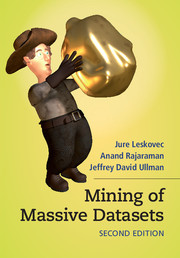Book contents
- Frontmatter
- Contents
- Preface
- 1 Data Mining
- 2 MapReduce and the New Software Stack
- 3 Finding Similar Items
- 4 Mining Data Streams
- 5 Link Analysis
- 6 Frequent Itemsets
- 7 Clustering
- 8 Advertising on the Web
- 9 Recommendation Systems
- 10 Mining Social-Network Graphs
- 11 Dimensionality Reduction
- 12 Large-Scale Machine Learning
- Index
- References
5 - Link Analysis
Published online by Cambridge University Press: 05 December 2014
- Frontmatter
- Contents
- Preface
- 1 Data Mining
- 2 MapReduce and the New Software Stack
- 3 Finding Similar Items
- 4 Mining Data Streams
- 5 Link Analysis
- 6 Frequent Itemsets
- 7 Clustering
- 8 Advertising on the Web
- 9 Recommendation Systems
- 10 Mining Social-Network Graphs
- 11 Dimensionality Reduction
- 12 Large-Scale Machine Learning
- Index
- References
Summary
One of the biggest changes in our lives in the decade following the turn of the century was the availability of efficient and accurate Web search, through search engines such as Google. While Google was not the first search engine, it was the first able to defeat the spammers who had made search almost useless. Moreover, the innovation provided by Google was a nontrivial technological advance, called “PageRank.” We shall begin the chapter by explaining what PageRank is and how it is computed efficiently.
Yet the war between those who want to make the Web useful and those who would exploit it for their own purposes is never over. When PageRank was established as an essential technique for a search engine, spammers invented ways to manipulate the PageRank of a Web page, often called link spam. That development led to the response of TrustRank and other techniques for preventing spammers from attacking PageRank. We shall discuss TrustRank and other approaches to detecting link spam.
Finally, this chapter also covers some variations on PageRank. These techniques include topic-sensitive PageRank (which can also be adapted for combating link spam) and the HITS, or “hubs and authorities” approach to evaluating pages on the Web.
PageRank
We begin with a portion of the history of search engines, in order to motivate the definition of PageRank, a tool for evaluating the importance of Web pages in a way that it is not easy to fool. We introduce the idea of “random surfers,” to explain why PageRank is effective. We then introduce the technique of “taxation” or recycling of random surfers, in order to avoid certain Web structures that present problems for the simple version of PageRank.
5.1.1. Early Search Engines and Term Spam
There were many search engines before Google. Largely, they worked by crawling the Web and listing the terms (words or other strings of characters other than white space) found in each page, in an inverted index.
- Type
- Chapter
- Information
- Mining of Massive Datasets , pp. 154 - 190Publisher: Cambridge University PressPrint publication year: 2014



